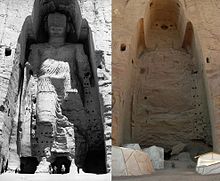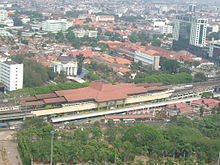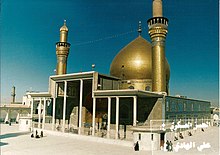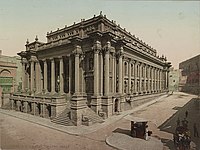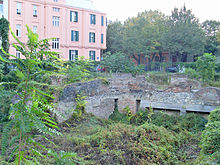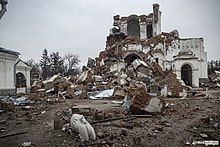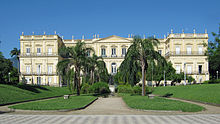
The conversion of non-Islamic places of worship into mosques occurred during the life of Muhammad and continued during subsequent Islamic conquests and invasions and under historical Muslim rule. Hindu temples, Jain Temples, churches, synagogues, and Zoroastrian fire temples have been converted into mosques.

The Vilnius Castle Complex is a group of cultural, and historic structures on the left bank of the Neris River, near its confluence with the Vilnia River, in Vilnius, Lithuania. The buildings, which evolved between the 10th and 18th centuries, were one of Lithuania's major defensive structures.

The Citadel of Aleppo is a large medieval fortified palace in the centre of the old city of Aleppo, northern Syria. It is considered to be one of the oldest and largest castles in the world. Usage of the Citadel hill dates back at least to the middle of the 3rd millennium BCE. Occupied by many civilizations over time – including the Greeks, Armenians, Romans, Byzantines, Ayyubids, Mamluks and Ottomans – the majority of the construction as it stands today is thought to originate from the Ayyubid period. An extensive conservation work took place in the 2000s CE by the Aga Khan Trust for Culture, in collaboration with Aleppo Archeological Society. Dominating the city, the Citadel is part of the Ancient City of Aleppo, an UNESCO World Heritage Site since 1986 CE. During the 2010s, the Citadel received significant damage during the lengthy Battle of Aleppo. It was reopened to the public in early 2018 CE with repairs to damaged parts underway, though some of the damage will be purposefully preserved as part of the history of the citadel. The citadel was damaged by the 2023 Turkey–Syria earthquake.

The Citadel, also known as the Castello, is the citadel of Victoria on the island of Gozo, Malta. The area has been inhabited since the Bronze Age, and the site now occupied by the Cittadella is believed to have been the acropolis of the Punic-Roman city of Gaulos or Glauconis Civitas.

The destruction of Warsaw was Nazi Germany's razing of the city in late 1944, after the 1944 Warsaw Uprising of the Polish resistance. The uprising infuriated German leaders, who decided to destroy the city in retaliation.
The appearance of Saint Petersburg includes long, straight boulevards, vast spaces, gardens and parks, decorative wrought-iron fences, monuments and decorative sculptures. The Neva River itself, together with its many canals and their granite embankments and bridges help to give the city its particular ambience.
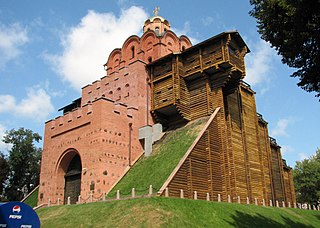
Ukrainian architecture has initial roots in the Eastern Slavic state of Kievan Rus'. After the Mongol invasion of Kievan Rus', the distinct architectural history continued in the principalities of Galicia-Volhynia and later in the Grand Duchy of Lithuania. During the epoch of the Zaporozhian Cossacks, a style unique to Ukraine developed under the influences of the Polish–Lithuanian Commonwealth.
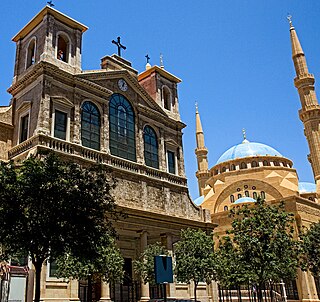
The tourism industry in Lebanon has been important to the local economy historically and comprises a major source of revenue for the country.

Reconstruction in architectural conservation is the returning of a place to a known earlier state by the introduction of new materials. It is related to the architectural concepts of restoration and preservation, wherein the most extensive form of reconstruction is creating a replica of a destroyed building.

Ostrów Tumski is an island between two branches of the river Warta in the city of Poznań in western Poland. Poznań Cathedral and other ecclesiastical buildings occupy the central part of the island. Ostrów Tumski is part of the city's former Nowe Miasto district, although it is actually the oldest part of the city, where the rulers of the early Polish state in the 10th century had one of their palaces.

The architecture of Lebanon embodies the historical, cultural and religious influences that have shaped Lebanon's built environment. It has been influenced by the Phoenicians, Romans, Byzantines, Umayyads, Crusaders, Mamluks, Ottomans and French. Additionally, Lebanon is home to many examples of modern and contemporary architecture. Architecturally notable structures in Lebanon include ancient thermae and temples, castles, churches, mosques, hotels, museums, government buildings, souks, residences and towers.
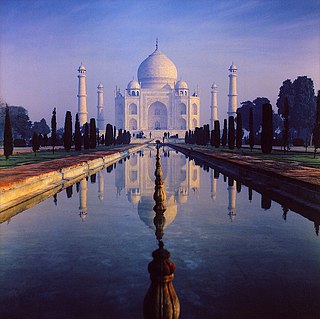
The architecture of Uttar Pradesh demonstrates a diverse and eclectic combination of Buddhist, Hindu, Indo-Islamic, and Indo-European architectural styles. Three of its architectural monuments—the Taj Mahal, the Agra Fort, as well as the township of Fatehpur Sikri founded by the Mughal emperor Akbar—are designated UNESCO World Heritage Sites. The architectural structures in Uttar Pradesh include ancient Buddhist stūpas and vihāras, ancient Buddhist and Hindu monasteries, townships, forts, palaces, temples, mosques, mausoleums, memorials, and other community structures. Uttar Pradesh's architectural structures also include various Hindu temples, Ghats, etc. largely found in ancient cities like Benares (Varanasi), Brindaban (Vrindavan), Mathura, and Prayagraj (Allahabad).
The architecture of Kosovo dates back to the Neolithic period and includes the Copper, Bronze and Iron Ages, Antiquity and the Medieval period. It has been influenced by the presence of different civilizations and religions as evidenced by the structures which have survived to this day. Local builders have combined building techniques of conquering empires with the materials at hand and the existing conditions to develop their own varieties of dwellings.

Deliberate destruction and theft of cultural heritage have been conducted by the Islamic State (IS) since 2014 in Iraq, Syria, and to a lesser extent in Libya. The destruction targets various places of worship under IS control and ancient historical artifacts. In Iraq, between the fall of Mosul in June 2014 and February 2015, IS had plundered and destroyed at least 28 historical religious buildings. Valuable items from some buildings were looted in order to smuggle and sell them to foreigners to finance the running of the Islamic State.
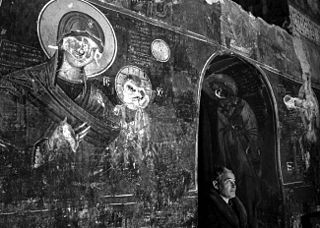
Serbian cultural and religious sites in Kosovo were systematically vandalized and destroyed over several historical periods, during the Ottoman rule, World War I, World War II, Yugoslav communist rule, Kosovo War and 2004 unrest.

The Temple of Baalshamin was an ancient temple in the city of Palmyra, Syria, dedicated to the Canaanite sky deity Baalshamin. The temple's earliest phase dates to the late 2nd century BC; its altar was built in 115 AD, and the temple was substantially rebuilt in 131 AD. The temple would have been closed during the persecution of pagans in the late Roman Empire in a campaign against the temples of the East made by Maternus Cynegius, Praetorian Prefect of Oriens, between 25 May 385 to 19 March 388. With the spreading of Christianity in the region in the 5th century AD, the temple was converted to a church.

The architectural heritage of the Kosovo Albanians during Yugoslav rule was shown institutionalised disregard for decades prior to outright conflict at the end of the 20th century. Numerous Albanian cultural sites in Kosovo were destroyed during the period of Yugoslav rule and especially the Kosovo conflict (1998-1999) which constituted a war crime violating the Hague and Geneva Conventions. In all, 225 out of 600 mosques in Kosovo were damaged, vandalised, or destroyed alongside other Islamic architecture during the conflict. Additionally 500 Albanian owned kulla dwellings and three out of four well-preserved Ottoman period urban centres located in Kosovo cities were badly damaged resulting in great loss of traditional architecture. Kosovo's public libraries, of which 65 out of 183 were completely destroyed, amounted to a loss of 900,588 volumes, while Islamic libraries sustained damage or destruction resulting in the loss of rare books, manuscripts and other collections of literature. Archives belonging to the Islamic Community of Kosovo, records spanning 500 years, were also destroyed. During the war, Islamic architectural heritage posed for Yugoslav Serb paramilitary and military forces as Albanian patrimony with destruction of non-Serbian architectural heritage being a methodical and planned component of ethnic cleansing in Kosovo.





